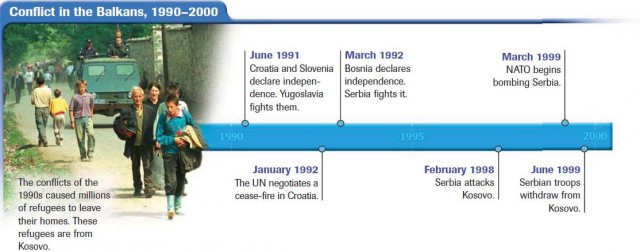Turmoil in the Balkans
A HUMAN PERSPECTIVE The Serbian leader Slobodan Milosevic tried to increase Serbia's power over the rest of Yugoslavia. As a result, in 1991 and 1992, four republics left Yugoslavia. Serbia went to war against them but lost. In 1999, an international court accused Milosevic (who was the Yugoslav president by then) and Serbian troops of war crimes in those conflicts. Many nations ended trade with Yugoslavia in protest, and the country grew poorer. In 2000, Yugoslavia voted Milosevic out of office. When he refused to accept the election results, thousands of people protested until he admitted defeat. In doing so, the Yugoslav people showed that they wanted peace and a normal relationship with the world. This may have been a turning point in the long history of conflict in the Balkans.
Roots of the Balkan Conflict
One conflict in the Balkans is that different groups want control of the same land. The causes of this conflict go back centuries. In the 500s, Slavic people migrated from Poland and Russia and settled in the Balkan Peninsula. They were called the South Slavs. Each group of South Slavs (the Croats, the Slovenes, and the Serbs) formed its own kingdom.
FOREIGN RULERS
In the 1300s, the Muslim Ottoman Empire tried to conquer the Balkan Peninsula. In 1389, the Ottomans defeated the Serbian Empire at the Battle of Kosovo Polje. The Ottomans also ruled Bosnia and Herzegovina. Elsewhere in the Balkans, Austria ruled Slovenia, and Hungary ruled Croatia. Over time, foreign rule created differences among the South Slavs. For instance, under Muslim rule, the Serbs clung to Christianity, while many Bosnians converted to Islam. Both Serbs and Albanians had lived in Kosovo, a part of the Serbian Empire. When the Muslims seized power, many Serbs fled Kosovo, so the region became more Albanian in culture.
YUGOSLAVIA IS FORMED
In 1878, Serbia broke free of the Ottoman Empire. Many Serbs wanted all the South Slavs to be free of foreign rule and to unite in one nation. That desire helped to spark World War I. In 1918, the Kingdom of the Serbs, Croats, and Slovenes was formed. In 1929, the king renamed it Yugoslavia (which means “Land of the South Slavs”) to help end ethnic divisions.

COMMUNIST RULE
During World War II, Germany and Italy invaded Yugoslavia. The Croats cooperated with the Nazis, and the Croat leader ordered the massacre of Jews and Serbs. Many other Yugoslavs joined the Chetniks or the Partisans, two rival groups fighting the Nazis.
One Partisan leader was Josip Broz Tito, head of the Communist Party. After the war, Tito became the dictator of Yugoslavia. He encouraged the Serbs, Croats, and other groups to think of themselves as Yugoslavs. In 1946, a new constitution organized Yugoslavia into a nation of six republics: Bosnia and Herzegovina, Croatia, Macedonia, Montenegro, Serbia, and Slovenia. Serbia had two self-governing provinces, Kosovo and Vojvodina. The map on page 322 shows that Croatia and Bosnia were ethnically mixed and contained many Serbs.
Ethnic Tension Boils Over
In 1980, Tito died, and the presidency began to rotate among leaders from the many republics and provinces. No single person ran the country.
FEAR OF SERBIA
Slobodan Milosevic began to propose the creation of a Greater Serbia. Serbia would expand its borders to include other territories with Serbian populations. This plan alarmed Croats and Bosnians.
Then in 1991, Serbia blocked a Croat from becoming president. In response, Slovenia and Croatia declared their independence. In June 1991, the Serbian-led Yugoslav army invaded both republics. The Slovenes quickly achieved freedom. But Croatia had a large Serbian minority, and past Serb-Croat hatreds exploded in all-out war. The fighting claimed thousands of lives before the United Nations arranged a cease-fire in January 1992. Slovenia and Croatia remained free.
WAR IN BOSNIA
In March 1992, Bosnia and Herzegovina declared independence. Bosnia's Muslims and Croats backed the move, but its Serbs (and Serbia) launched a war to stop it. The Serbs used murder and violence to get rid of Bosnia's Muslims and Croats. The policy of trying to eliminate an ethnic group through violence is called ethnic cleansing. More than 200,000 people died, while over 2 million people fled their homes.
In 1995, the United States sponsored peace negotiations, and in December, a peace treaty was signed. Bosnia remained independent.
WAR IN KOSOVO
The Serbs had never forgotten their long-ago defeat at Kosovo Polje. They saw the province as a sacred part of Serbia's heritage. But in the 1990s, Kosovo was inhabited mostly by Albanians, who spoke a non-Slavic language and whose religion was Islam.
Serbia, led by Miloshevic, tried to assert control over Kosovo and to wipe out its Albanian culture. In response, Kosovo demanded independence. In the 1990s, a group called the Kosovo Liberation Army (KLA) began to carry out attacks against Serbian officials. The Serbian government responded by bombing villages and began a campaign of ethnic cleansing against Albanians.
In March 1999, NATO started bombing Serbia to force it to stop the violence. In June, Miloshevihc withdrew his troops from Kosovo. After they pulled out, international officials found horrifying evidence that the Serbs had carried out tortures and massacres.
AN UNCERTAIN FUTURE
In 2000, the Yugoslav people elected a reform leader named Vojislav Kostunica as president. Even as Kostunica took office, the outlook for peace was unclear. Ethnic loyalties still created tension. The decade of wars had created millions of refugees. And the wars' destruction had created widespread poverty. Another cause of tension was that many people in Kosovo and the republic of Montenegro wanted independence.
In 2003, Serbia and Mongengro officially replaced what remained of the former Yugoslavia by becoming a new country called Serbia and Montenegro. Section 2 discusses an issue that affects not only the Balkans but all of Europe—pollution.